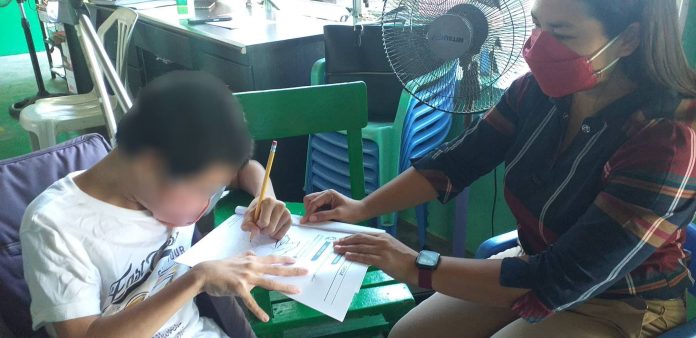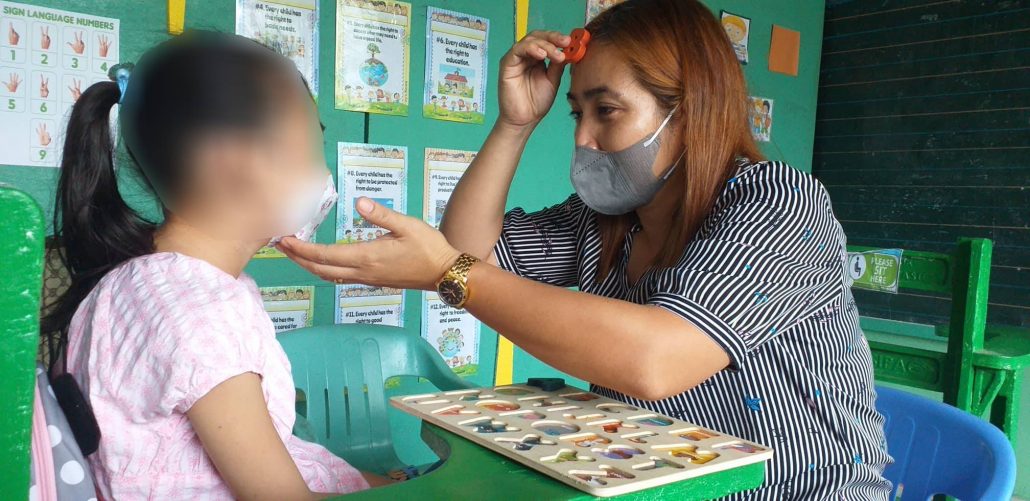
“DAW mauntat na kami eskwela, pero indi ko mabatas ang akon apo (It was really hard; I once thought of giving up on my grandson’s education, but I can’t afford that).”
For Perla Villegas, 72, being a grandmother to James (not his real name), a 13-year-old man with cerebral palsy, is grueling, but all she wanted was the best for him.
James availed himself of a special education program at the SPED Center of New Lucena Central School in New Lucena, Iloilo province. Perla and another grandmother looked after James, whose mother was working in another country while his father was in prison. More than assisting James with eating and using the comfort room, plus the pressing household chores, Perla served as James’ teacher during the pandemic.
“Nag-pandemic. Mas nagbudlay pa gid (The pandemic exacerbated our situation),” shared Perla. “Gusto ko gid nga makasulat sia kag basa. Pero kabudlay mag-asister kay indi man ako makamurot sang iya module (I wanted him to be able to read and write. But it was difficult to assist him with his studies because of my poor eyesight).”
But thinking of her grandson’s future is what motivates her to step forward.
Perla was thankful for the resumption of face-to-face classes; she believed this would be more effective.
Jonalyn Montaño, mother of 18-year-old Niña (not her real name), agreed.
“Iba gid kon teacher niya sa school ang matudlo kay mas madasig niya makuha ang lesson (She can easily pick up the lessons because teachers have their own strategies),” said Montaño, a resident of Barangay Janipaan East in Mina, Iloilo.
The SPED Center in Mina town, a nearby municipality of New Lucena, used to be where Niña attended school, but it has since closed.
They left Mina and relocated to New Lucena because of her wish to continue her child’s studies.
She said they enrolled their daughter at the SPED Center because they wanted her to lead a happy life as she got older.
Even merely reading and counting money, Montaño cried, “I pray she can do that. I have no other hope but that she will be able to read and think, so eventually she will not be tricked by others.”
“I told my other kids to love Inday and be role models for others. Never fight with Inday because if others see that, they will think it’s okay to hurt her,” added Montaño.
To the parents, Montaño said they should not embarrass their children, but instead try to bring them to school so that they can learn.
“Parents of children with special needs have been overwhelmed. Adjustment to blended learning was arduous—juggling the mother-teacher responsibilities in one,” shared by Joan Bertomo, a special education teacher at New Lucena Central School SPED Center in New Lucena, Iloilo.
The SPED Center has 51 learners enrolled for the school year 2022-2023. In the past school years, even amid the pandemic, enrollment hovered at 50. Bertomo said this implies the determination of parents of kids with special needs to send them to school.
Each learner has different special needs or disabilities, including cerebral palsy, intellectual disability, communication difficulties, hearing impairment, vision impairment, and autism spectrum disorder.
According to Bertomo, these learners require consistent mode of teaching for them to develop their maximum potential.
However, the pandemic totally changed the traditional face-to-face mode of learning.
Only the parents or guardians were guiding the kids in answering their modules, she said. It was not consistent though, as the parents’ top priority was to make ends meet. Home visitations were also prohibited at that time.
While it is true that parents or guardians supervise the teaching of other daily life skills, such as doing household chores and toileting, Bertomo said it is inevitable that some learners may forget what was taught in schools before the pandemic.
“We were left with no choice but to start over,” said Bertomo, who is in her 11th year of being a SPED teacher.
Another SPED teacher, Ma. Andrea Gobuyan, echoed Bertomo.

According to Gobuyan, parents or guardians have difficulty teaching the modules to their children since they tend to be disobedient. This contrasts with face-to-face sessions where the teacher employs a variety of strategies and approaches to manage the students.
The kids can even deceive their parents and exhibit various disruptive behaviors that eventually result in crying, she added. Unfortunately, certain modules were left unanswered.
“Parents frequently comment, ‘They are just too sluggish, ma’am, there is no way to answer.’ Therefore, that is what we are working on: teaching them small-scale parenting techniques,” Gobuyan added.
The resumption of face-to-face classes has alleviated the burden on parents and guardians in teaching their children, and it can be assured that learners with special needs can learn well after being handled personally by teachers.
However, Bertomo acknowledged that they are having some difficulties encountered during face-to-face lessons.
Lack of rooms for special education classes for children is one such instance. The 49 learners with special needs currently only have access to one classroom with three teachers, according to Bertomo.
The three teachers’ approaches in a small classroom involve one-on-one classes, small groupings (two to four learners) basing on the same categories and learners’ learning paces. To accommodate the huge number of learners, the teachers have scheduled them based on learners’ categories.
Fifty-one learners are being grouped according to their categories and levels.
Teacher Cheryl Clarin is handling 12 learners with intellectual disability while Bertomo is handling 13 learners with (9) intellectual disability, (2) cerebral palsy and (2) visual impairment. Gobuyan is handling 14 learners with (4) hearing impairment, (4) autism spectrum disorder, (3) intellectual disability, and (3) communication disorders.

Each teacher is handling two scheduled classes per set. Set A: Monday & Tuesday (7:30 a.m.-9:30 a.m. and 9:30 a.m-11:00 a.m.) and Set B Thursday & Friday (7:30 a.m.-9:30 a.m. and 9:30 a.m.-11:00 a.m.).
Every Wednesday is allotted for classroom/school disinfection.
There is indeed a catastrophic world inside a classroom with three different classes, teachers are talking and discussing while learners are screaming and learning at the same time.
Bertomo said after they divided the entire classroom into three groups, their setup in the classroom will be challenging.
When one group of learners is answering activity sheets, another class works on sign language exercises so as not to disrupt the other group. The SPED Center’s instructors cover fundamental concepts like alphabets, sounds, numbers, and literacy.
The spread of COVID-19 presents another challenge for educators and students as they resume face-to-face instruction.
Since they are working with special-needs children, Bertomo noted, it is inevitable that they will interact with the students. As a result, the teachers are ensuring that the safety procedures are followed. There is a temperature check and hand washing facilities at the gate entrance. The wearing of face masks and physical distancing inside classrooms are strictly enforced.
Except for a small number of students who cannot be immunized due to health reasons, all the teachers at the SPED Center are fully vaccinated against the viral disease.
‘BREAK THE STIGMA’
Love and long patience. This is the teacher’s weapon to teach kids with special needs.
According to Bertomo, they also want to lessen the stress that the students experience by imparting fundamental knowledge so that later, when their parents or siblings are no longer able to support them, they will be able to stand on their own.
“Let’s be supportive of our children,” she stressed.
Bertomo and Gobuyan are urging parents or legal guardians of children with special needs to break the stigma.
Gobuyan clarified that when teaching children with special needs, their sole goal is to help them integrate into the community so that they do not feel abandoned or even discriminated against.
Gobuyan urges the incoming SPED instructors to keep advocating for the needs of students with disabilities.
“We can do it for the children,” she said.
FULL SUPPORT
Support for students, especially those with special needs, has been made available thanks to the Department of Education Region 6 (DepEd-6) and the local government of New Lucena and the province of Iloilo.
In order to bring services closer to students, Hernani Escullar, Jr., information officer for DepEd-6, said DepEd is working to address the issue of the lack of classrooms and schools for all students, particularly in special education.
DepEd-6 does not currently have information regarding the number of students with special needs in Region 6 since data segregation is still ongoing.
As of August 22, Region 6 had 2,233,946 students enrolled for the school year 2022-2023, accounting for 106.17 percent of the total. This is higher when compared to the last school year 2020-2021 which only reached 2,104,060 learners.
In addition to classrooms, DepEd will continue to help schools buy instructional supplies and other equipment to enforce the basic public health standards among students.
According to Iloilo Gov. Arthur Defensor Jr., through the Iloilo Province School Board, the provincial government has allotted P203 million for programs and initiatives of public schools, including SPED centers, for the academic year 2022-2023.
The following programs and projects will be implemented in public schools: building extra classrooms to prepare for the full implementation of face-to-face classes; enhancing farm schools; installing water systems; constructing restrooms and laundry facilities; purchasing computers and other educational materials; purchasing medical and dental supplies; and others.
“We are developing robust classrooms, water systems, wash areas, toilets, and more as part of the education curriculum that I am drafting,” according to Defensor.
The provincial government set aside P160 million for public schools for the academic year 2020-2021.
The SPED Center encourages other persons with special needs to avail themselves of special education program.
On the part of the local government unit (LGU) of New Lucena, Mayor Liecel Mondejar-Seville will continue to extend support to the New Lucena Central School, particularly to the SPED Center.
According to Seville, there is a constant dialogue with persons with disabilities to know their concerns and act on them. The LGU, through the barangays, encourages these PWDs to go to school. With the high number of enrollees this school year, the local chief executive said the dialogue is a successful method of encouraging parents to send their kids to school.
New Lucena, being awarded as a child-friendly municipality, will continue advancing equal and quality education as well as an inclusive, barrier-free, and rights-based society for students with developmental challenges, she emphasized.
***
This story is part of the journalism fellowship of the Philippine Press Institute under the auspices of the Hanns Seidel Foundation./PN







